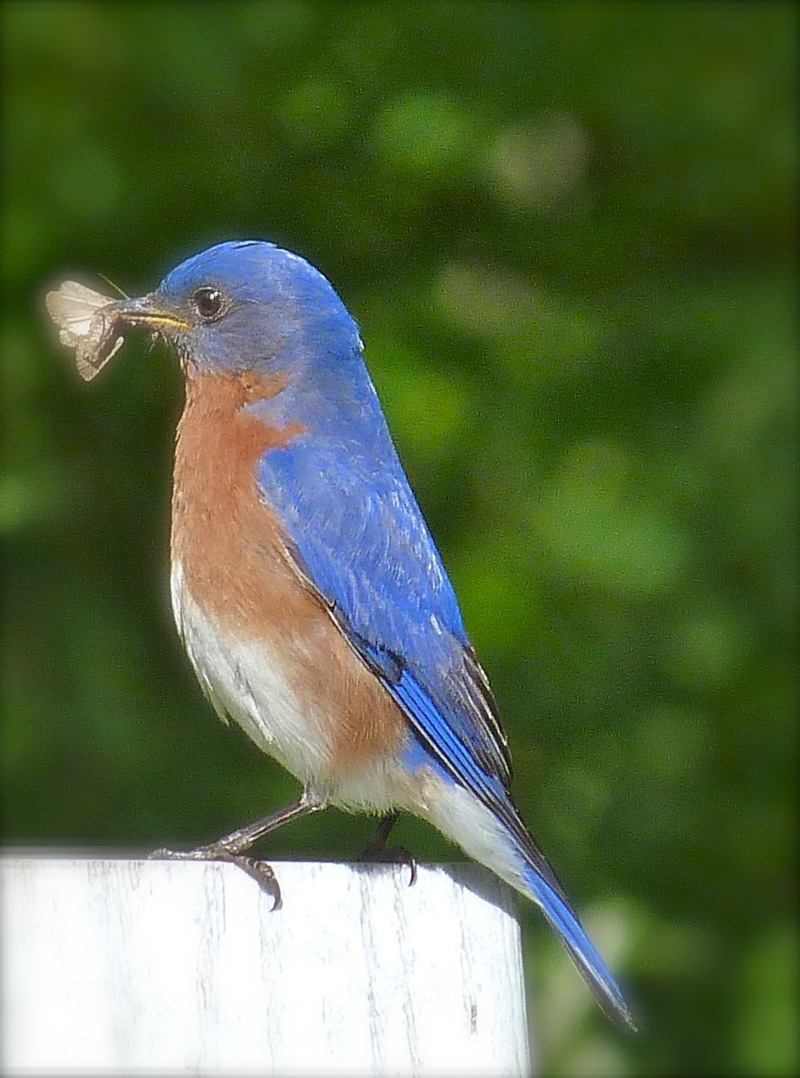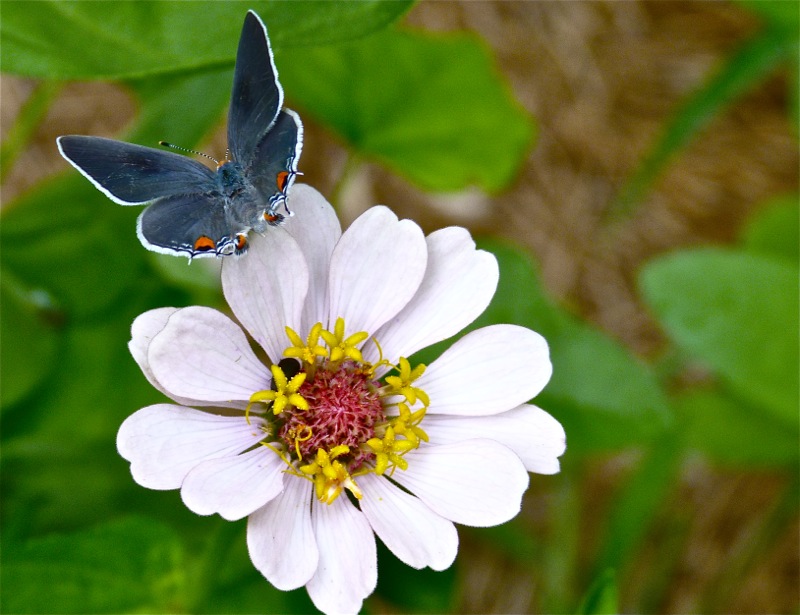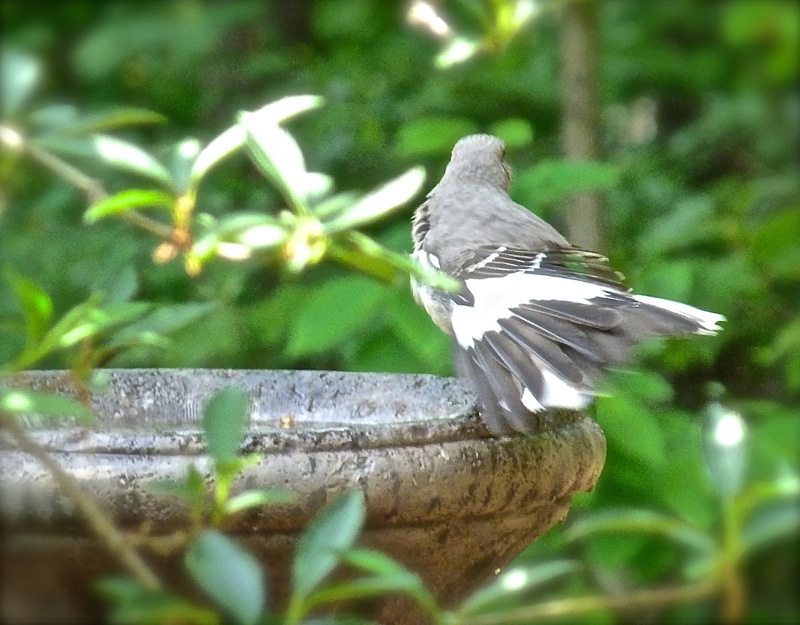Planting a Wildlife Habitat
 Monday, January 27, 2014 at 5:00AM
Monday, January 27, 2014 at 5:00AM After wandering around my garden, a visitor once turned to me and exclaimed, "The birds are so happy!"
That made me very happy, too. I get great joy watching the many birds, squirrels, rabbits, and even occasional foxes who visit my garden. I love lizards, butterflies, dragonflies, ladybugs, and bees. I feel good that so many creatures choose to live in my garden. A healthy garden is one that is full of life.A few of the creatures that call my garden home, clockwise from top left: A green Anole lizard; Bumblebee, Chipmunk (Ground squirrel); Barred owl.
If we create an environment that is good for wildlife, often that garden will be a place that is pleasing to us as well. There are a number of things a gardener can do to make a habitat that is friendly to wildlife.
If you are serious about attracting wildlife to your garden, be sure to use only organic products, rather than artificial fertilizers, pesticides, and insecticides that can harm wildlife. I cringe at those products that have a nuke-em approach, promising to get rid of every bug. Many insects are good guys who eat other bugs that damage our gardens, and insects are an important food source for many birds and other forms of wildlife. This Eastern Bluebird is enjoying a tasty meal.
This Eastern Bluebird is enjoying a tasty meal.
Also, plant a variety of both evergreen and deciduous plants in your garden. This is the best way to insure that your garden will become a wildlife habitat. A diversity of plantings will provide shelter throughout the year, as well as places for birds to nest and raise their young.
A diversity of plantings will provide shelter throughout the year, as well as places for birds to nest and raise their young. Cardinals have nested in this forsythia bush every year since we moved here in 1985.Trees and shrubs that produce berries - for example: hollies, dogwood, viburnum, hawthorn, and serviceberries - as well as flowering plants that are allowed to go to seed, will provide sustenance.
 A robin eats dogwood berries in winter.
A robin eats dogwood berries in winter.Clockwise from top left are some of the berry-producing plants in my own garden: Burford holly; Mapleleaf viburnum; Weeping yaupon holly; Serviceberry tree
Rose hips and Coneflower seeds are only a couple of the many types of seed heads that birds and other wildlife consume through the winter.
Many of us enjoy watching the aerial acrobatics of hummingbirds.  Yes, hummingbirds do perch!If you want to attract these amazing creatures, plant brightly colored, nectar-rich flowers that have funnel-shaped blooms as well as those that have distinct “landing zones”. Trumpet creeper, Campsis radicans; Trumpet honeysuckle, Lonicera sempervirens; Bee Balm, Monarda didyma; Indian Pink, Spigelia marilandica; and Red buckeye, Aesculus pavia, are some of our native plants that attract hummingbirds. Rose of Sharon, Hibiscus syriacus; Pineapple sage, Salvia elegans; Shrub verbena, Lantana camera; Giant blue sage, Salvia guaranitca; and Butterfly bush, Buddleja davidii are a few of the non-natives that attract hummingbirds. Spearleaf swampmallow, Pavonia hastata, which is in the hibiscus family, is a favorite in my own garden. Often hummingbirds will ignore the nearby hummingbird feeder and fight over this!
Yes, hummingbirds do perch!If you want to attract these amazing creatures, plant brightly colored, nectar-rich flowers that have funnel-shaped blooms as well as those that have distinct “landing zones”. Trumpet creeper, Campsis radicans; Trumpet honeysuckle, Lonicera sempervirens; Bee Balm, Monarda didyma; Indian Pink, Spigelia marilandica; and Red buckeye, Aesculus pavia, are some of our native plants that attract hummingbirds. Rose of Sharon, Hibiscus syriacus; Pineapple sage, Salvia elegans; Shrub verbena, Lantana camera; Giant blue sage, Salvia guaranitca; and Butterfly bush, Buddleja davidii are a few of the non-natives that attract hummingbirds. Spearleaf swampmallow, Pavonia hastata, which is in the hibiscus family, is a favorite in my own garden. Often hummingbirds will ignore the nearby hummingbird feeder and fight over this!In my own garden, hummingbirds prefer Trumpet honeysuckle and Pavonia hastata.
Butterflies are also welcome inhabitants of our gardens. They are attracted to colorful perennials and annuals such as Zinnia: Pentas:
Pentas: Cosmos:
Cosmos: Below, clockwise from top left, are more butterfly magnets: Coneflower, Echinacea; Blue mist shrub, Caryopteris; Butterfly weed, Asclepsias; and of course, Butterfly bush, Buddleja.
Below, clockwise from top left, are more butterfly magnets: Coneflower, Echinacea; Blue mist shrub, Caryopteris; Butterfly weed, Asclepsias; and of course, Butterfly bush, Buddleja.
Butterflies are also drawn to asters, salvia, and to many flowering shrubs, such as azaleas.
Remember that a water source is important to wildlife, even through the winter. I dream of a pond or a stream, but for now I maintain a couple of birdbaths. I managed to get a rear view of this mockingbird enjoying a birdbath.Many natural wildlife habitats are perishing as modern society expands. We gardeners should do more than just make our yards pretty for ourselves. We can help preserve the local ecology by providing safe and healthy environments for garden creatures. Ultimately, we are benefitting our own lives, as well.
I managed to get a rear view of this mockingbird enjoying a birdbath.Many natural wildlife habitats are perishing as modern society expands. We gardeners should do more than just make our yards pretty for ourselves. We can help preserve the local ecology by providing safe and healthy environments for garden creatures. Ultimately, we are benefitting our own lives, as well.
"Are not two sparrows sold for a penny? Yet not one of them will fall to the ground outside your Father's care." Matthew 10:29

Reader Comments (10)
A great and inspiring post Debs! Encouraging wildlife into the garden cannot by done enough, and by doing so the garden finds its own balance that will both be beneficial to the wildlife, plants, and the gardener. A garden teeming with life is a joy to be in, to see, and to own.
Lovely post Deb, by planting the right trees, shrubs and perennials we can attract all sorts of wildlife into our gardens. When we first came here it was a desert, almost as far as wildlife was concerned, but gradually over the years the wildlife has increased as we have provided shelter and food for it. We get as much pleasure from seeing the wildlife in the garden as from the plants themselves.
Great post and what a coincidence I'm giving a talk to a local gardening group tomorrow about planting to encourage wildlife. your garden is a lesson to all.
Great post! I shudder to think of all the damage all the chemicals are doing to nature. So many different species are in decline and becoming endangered. I take hope in the fact that I think more and more people are becoming aware of this. It is up to us to try to help out the wildlife and environment when we can.
Your garden is a true wildlife paradise Deb. I agree with everything you said and with the comments above. Hopefully one day all gardeners will think this way. Your photographs are so beautiful. I am surprised that a red bird makes its nest in a yellow shrub.
Hello, everyone! I appreciate each comment very much. Denise, by the time the babies have hatched, that shrub is a solid thicket of green and is very difficult to see into. Deb
Wow...I love all the wildlife in your gardens and your photography is just stunning! You have the perfect balance of structure and color to attract such a variety of animals. I am fascinated with hummingbirds and plant so that they will come to my garden but have only sighted them on the property three times in the past thirty years. They are most attracted to the lantana I put out every summer but they come and go so quickly that it is too difficult to get a picture. I am trying the hummingbird feeder again this season but am putting it out much earlier to attract them. This was a beautiful and informative post!
What an amazing post highlighting what I consider the most important points to be considered when gardening! I too get the comment all the time, I can hear the birds singing. It is a sad fact that in many chemical laden gardens of today you can't hear the birds singing because they aren't there. I garden and run my nursery completely organically and don't feel that it is a drawback in any way.
Very well-written and perceptive, Deb. I was reading something the other day about how a place with birds is a good place, a safe place, and so on. I can't find the quote, but it was beautiful and made me happy to know that birds are happy in my garden. When they hang out here, I am very happy, too.
Oh my goodness, you do take beautiful shots of those birds, and animals. The mix of nature in your garden is stunning.
Our backyard was like a football field when we moved here 2 years ago...I am gradually working on making it a wildlife paradise...doing what I can, bit by bit. Already we have more of nature visiting us then any other house in the area...and that's what I am aiming for.
Jen